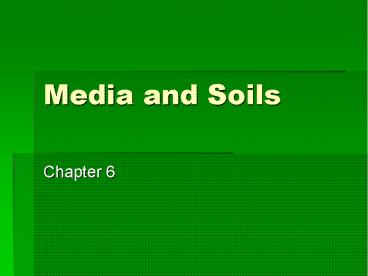Media and Soils - PowerPoint PPT Presentation
Title:
Media and Soils
Description:
Media and Soils Chapter 6 * Primary Nutrients N-P-K Needed in largest amounts. Secondary Nutrients Ca-Mg-S Needed in moderate amounts Micronutrients Needed in smaller ... – PowerPoint PPT presentation
Number of Views:387
Avg rating:3.0/5.0
Title: Media and Soils
1
Media and Soils
- Chapter 6
2
Learning Targets
- I can identify various types of growing media?
- I can explain the PH Scale?
- I can identify 3 sections of the Soil Triangle?
3
Growing Medium
- Material in which the roots plants grow.
4
Roles of Media
- Provides nutrients and a anchor for plant.
5
Nutrients
- Substance that roots absorb from the medium and
water.
6
Anchor
- Roots hold plant in place.
7
Pore Space
- Air holes between the growing medium particles
which allows oxygen to reach the roots of plants.
8
Soil Amendment
- Anything added to the soil to improve plant
growth. - Vermiculite
- Perlite
9
Soil
- Top few inches of earths surface that provide
soil growth.
10
Soilless Medium
- Contains no soil.
- Made from
- Vermiculite
- Perlite
- Peat Moss
- Bark
- Can be pre-mixed
11
Hydroponics
- Nutrients are provided by nutrient solution.
12
Nutrient Solution
- Contains water with dissolved nutrients.
13
Hydroponic Advantages
- Nutrients Control
- Yield is greater
- Roots do not spread
- Reduced Weed, Insect, Disease
14
Mineral Materials
- Come from inorganic sources.
- 3 kinds of Mineral Materials
15
Sand 1
- Largest material in soil.
- Good for soil drainage.
16
Silt 2
- Smaller than sand.
- Areas near rivers are high in silt.
17
Clay 3
- Smallest size particle in soil.
- Holds water well.
- Fills gaps between Sand and Silt
18
Organic Matter
- Decayed remains from plants and animals.
19
Soil Texture
- of Sand, Silt, Clay present in the soil.
20
Soil Triangle
- Used to classify soil on the basis texture
content. - Most crops prefer a Loamy soil.
21
Loam Soil
- High in Silt lower in Sand and Clay.
22
Soil Structure
- Physical arrangement of soil particles.
23
Soil Aeration
- Movement of air in the soil.
- Clay soil least air movement.
24
Soil Compaction
- Soil compressed into a dense mass.
25
Wear
- Physical deterioration of a plant community.
26
Soil Profile
- Vertical section of soil at a location.
27
Soil Horizon (A)
- Topsoil 10
- Made of
- Humus
- Roots
- Organisms
28
Soil Horizon (B)
- Subsoil 30
- Made of
- Fine Particles
- Leached materials
- Some Roots
29
Soil Horizon (C)
- Parent Material 48
- Made of
- Bedrock
- Leached materials
30
Soil Horizon (R)
- Bedrock
- Made of
- Solid Rock
31
Plant Nutrients
- 17 elements are needed for plants to grow.
32
Macronutrients
- Most important nutrients needed in large amount.
33
Macronutrients
- (N) Nitrogen
- (P) Phosphorus
- (K) Potassium
- (Ca) Calcium
- (Mg) Magnesium
- (S) Sulfur
34
Primary Nutrients
- N-P-K
- Needed in largest amounts.
35
Secondary Nutrients
- Ca-Mg-S
- Needed in moderate amounts
36
Micronutrients
- Needed in smaller amounts.
- AKA-Trace Elements
37
Micronutrients
- (Fe) Iron
- (Mn) Maganese
- (Zn) Zinc
- (Cu) Copper
- (B) Boron
- (Mo) Molybdenum
- (Cl) Chlorine
- (Ni) - Nickel
38
Soil Testing
- Determines what nutrients are present in the soil.
39
Nitrogen
- Key element
- Helps plant recover from damage.
40
Nitrogen Deficient Example
- Older leaves turn yellow. (Chlorosis)
- Death can happen
41
Phosphorus
- Helps plant hold and transfer energy for
metabolism.
42
Phosphorus Deficient
- Reduced growth
- Dark to reddish leaf colorations.
43
Potassium
- Important for plant life process.
44
Potassium Deficient
- Reduced growth
- Increase disease
- Stress of plant
45
Soil PH
- Ph is used to measure the amount of Alkalinity or
acidity in soil.
46
PH Scale
- 14 Point Scale
47
PH Scale
- 7.0 Neutral
48
PH Scale
- Below 7.0 Acidic
- Above 7.0 Alkaline
49
Modifying PH
- Adding Lime will raise PH.
- Adding Sulfur will lower PH.
50
Modifying PH
- Most plants prefer PH of 5.5-8.0
51
Fertilizer
- Any material used to provide the nutrients plants
need.
52
Fertilizer
- Can be applied as
- Solid
- Liquid
- Gas
53
Elemental Fertilizer
- Provides only 1 plant nutrient.
54
Complete Fertilizer
- Contains all 3 elemental nutrients.
- Nitrogen
- Potassium
- Phosphorus
55
Active Ingredient
- Total of nutrients that is being applied to
plants.
56
Inert Ingredient
- The carrier or filler ingredient that allows for
the spreading of the fertilizer.
57
Complete Fertilizer Example
- 16 Nitrogen
- 4 Phosphate
- 8 Potash
- 28 Active Ingredient
- 72 Inert Ingredient or carrier
58
Application Equipment
- Sprayers for liquid fertilizer.
59
Application Equipment
- Dry fertilizer for Granular Equipment.
- Spreader
60
Granular Fertilizer
- Applied with Rotary, Gravity Flow Spreader.
- Most common way of spreading fertilizer.
61
Fertigation
- Application of fertilizer with the use of
irrigation system. - Very fast to use.
- Water and fertilize at the same time.































